Equine Massage: A Practical Guide (18 page)
Read Equine Massage: A Practical Guide Online
Authors: Jean-Pierre Hourdebaigt

Principles and Concepts of Massage
81
Tapotements
Tapotement massage consists of a series of soft blows to the body, done rhythmically. Clapping, cupping, hacking, beating, and pounding are all tapotements. All these movements are mechanical and stimulating. Hands usually work alternately in a light and springy manner. The rhythm of application varies according to pressure. Light clapping, cupping, and hacking are done at approximately 2 to 3 beats per second for starters, then up to 6 beats per second when the horse is warmed up. Heavier beating and pounding are performed more slowly, at 2 to 3 beats per second.
The moves are mostly used to increase circulation and to energize the body; they are used frequently in therapeutic massage treatments, sports massage sessions, and in warm-up routines.
Done on their own, tapotements are very effective for warming up muscle groups just prior to exercise.Your horse might take some time to adapt to tapotements, but he will soon learn to like them. Start with a very light pressure and increase it progressively.
The application of tapotements should last a few minutes: 1 or 2
minutes over small areas and up to 3 minutes when working large parts. A strong, soothing feeling of relaxation will follow such an application.Try it on yourself and you will see. Always finish with some effleurages and strokings.
Clapping
Clapping is done with the palm of the hand, the hand flat and the fingers stretched as though applauding.
Use only 2 or 3 pounds of pressure to start, building to 5 or 10
pounds of pressure. Use only on muscle groups, not on bony structures, except over the ribcage. Keep the pressure light over thin muscles (scapular muscles, for example).
3.32 Tapotement: Clapping
3.33 Clapping Movement
Movement
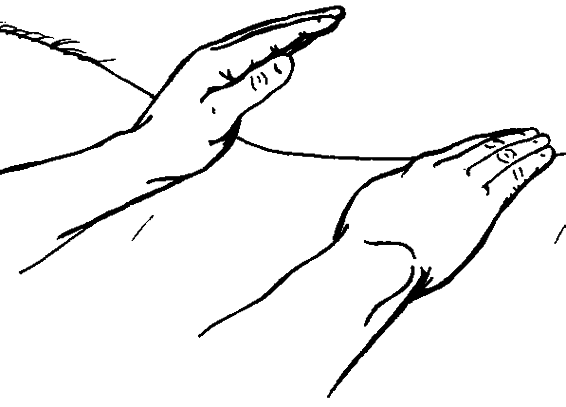
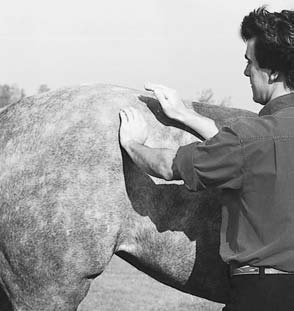

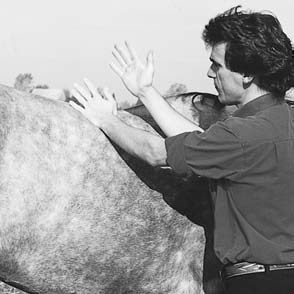
82
Equine Massage
3.34 Tapotement: Cupping
3.35 Cupping Movement
Movement
Cupping
Cupping is done with the palm of the hand cupped as though holding water.
Use 5 to 10 pounds of pressure.This is a softer version of clapping that is used over the rib cage and around bony structures (scapula, withers, hip, stifle, etc.) or over curved muscle areas (front chest, rump).
Hacking
Hacking is done in a springing manner with the flat side of the hand, the fingers spread out in a flexible, non-rigid manner.
Use 5 to 10 pounds of pressure, and up to 15 pounds when working over big, bulky muscles. Hacking penetrates deeper into
3.36 Tapotement: Hacking
3.37 Hacking Movement
Movement
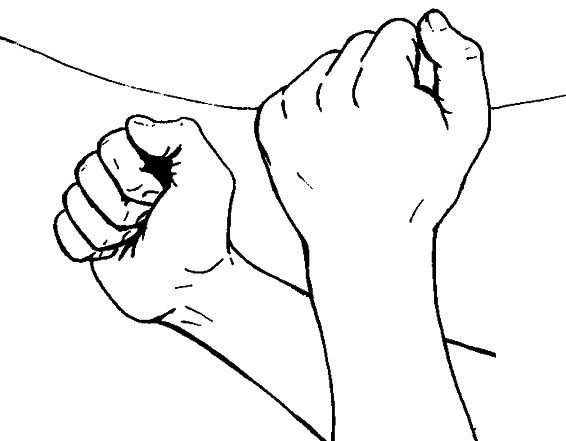
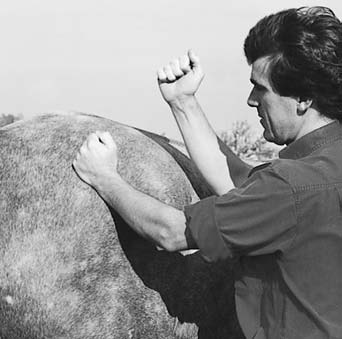
Principles and Concepts of Massage
83
the muscle structure and yet is very gentle. It is a favorite move to treat the back muscles or the thicker muscle of the hindquarters.
Beating
Beating is done with a relaxed closed fist, hitting the muscle groups with the flat side of the hand.
Pressure can be 10 to 15 pounds and up to 20 pounds over big muscle groups. Only use this move after you have already done several clapping, cupping, and hacking moves, and only over fleshy parts. A strong stimulation of fluid circulation will immediately follow this application.
3.38 Tapotement: Beating (Medium
Pressure) and Pounding (Heavy
Pressure) Movements
3.39 Beating or Pounding Movement
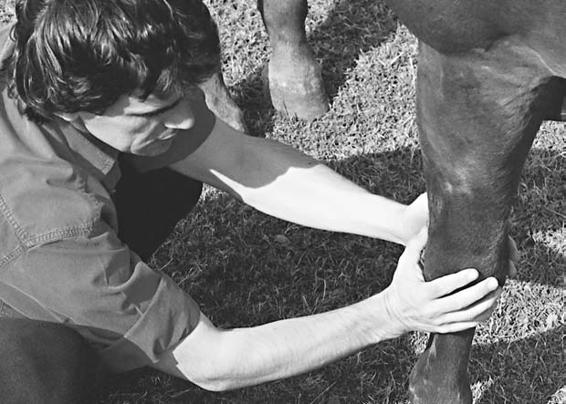
84
Equine Massage
Pounding
Pounding is a harder version of the beating move. The fist is clenched tight. Use a pressure of between 15 and 25 pounds.This move is rarely used except for deep stimulation of big muscle groups like those of the hindquarters.
The Laying on of Hands
The laying on of hands has great therapeutic value in soothing acute wounds, inflammation, nerve irritation, and stress of a mechanical or nervous origin even though it is not technically a classical massage movement.The technique is used where regular massage cannot be used; it is a great addition to regular treatment routines that furthers the soothing effect.
Put your hands gently over the area of concern and mindfully feel the energy, the vibration of that part. Use very little pressure (0.5 pound) for this simple hand contact. Be thoughtful of the moment, of the animal, of yourself as you do this.The feeling of closeness that will quickly develop between you and the animal is a sure sign of the effectiveness of this procedure. A warm feeling will develop between your hands. As the nervous stress connected to that particular problem releases, you will feel a heat wave coming out of the part treated.That heat wave will be proportional to the stress recorded and the pain involved.The laying on of hands will soothe the area and induce relaxation on both
3.40 Laying on of Hands
Principles and Concepts of Massage
85
the physiological and the nervous levels. A great feeling of relief will follow such procedure.
When massage is contraindicated, the laying on of hands will often bring soothing energy to an irritated area, relieving pain.
Cold hydrotherapy (such as a cold wet towel; see chapter 4) applied to the animal’s treated body part will also relieve inflammation and pain considerably.
Basic Massage Movements
Massage is classified into three basic groups: Soothing, stimulating, and producing a pure nervous reflex.
Soothing Massage Movements
A soothing massage can inhibit nerve impulses to the muscles, which results in relaxation.The soothing massage moves are:
❖ Slow stroking
❖ Gentle effleurage
❖ Fine vibration
❖ Fine shaking
❖ Gentle petrissage with kneading, muscle squeezing, wringing, and eventually gentle compressions—all done with very light pressure and in a peaceful rhythm
Stimulating Massage Movements
A stimulating massage produces a nerve-exciting reflex in the muscles. This reflex stimulates muscle tone (light contraction, causing an increase in blood and lymph circulation with resultant increased oxygenation, etc.).
Rhythm and pressure play important roles in the degree of stimulation you want to induce.Working in a hasty manner with abrupt changes of movement will irritate your animal very quickly. Therefore, always start gently and build up your pressure and rhythm accordingly.
Pressure need not be heavy. On a healthy structure, 10 to 20
pounds is plenty. The mechanical repetition of the movements will secure the desired effects.Always start lightly and monitor the feedback signs of your animal, adjusting proportionally.
In time and with practice you will develop a sense of all these nuances. You should always stay on the safe side by starting gently. As your horse becomes accustomed to massage, he will allow you to work deeper, especially if he is well warmed up.
86
Equine Massage
Always remember to ensure thorough drainage (via effleurage) after using stimulating moves.
The stimulating moves are:
❖ Fast stroking
❖ Firm to vigorous effleurage